Deck 10: Alcohols
Question
Question
Question
Question
Question
Question
Question
Question
Question
Question
Question
Question
Question
Question
Question
Question
Question
Question
Question
Question
Question
Question
Question
Question
Question
Question
Question
Question
Question
Question
Question
Question
Question
Question
Question
Question
Question
Question
Question
Question
Question
Question
Question
Question
Question
Question
Question
Question
Question
Question
Question
Question
Question
Question
Question
Question
Question
Question
Question
Question
Question
Question
Question
Question
Question
Question
Question
Question
Question
Question
Question
Question
Question
Question
Question
Question
Question
Question
Question
Question

Unlock Deck
Sign up to unlock the cards in this deck!
Unlock Deck
Unlock Deck
1/102
Play
Full screen (f)
Deck 10: Alcohols
1
What is the major organic product obtained from the reaction of 2,2-dimethyl-1-propanol aqueous HBr at reflux?
A) 1-bromo-2,2-dimethylpropane
B) 1-bromo-2-methylbutane
C) 2-bromo-2-methylbutane
D) 3-bromo-2-methylbutane
A) 1-bromo-2,2-dimethylpropane
B) 1-bromo-2-methylbutane
C) 2-bromo-2-methylbutane
D) 3-bromo-2-methylbutane
2-bromo-2-methylbutane
2
What is the IUPAC name of the following compound? 
A) (R)-2-methyl-4-pentanol
B) (S)-2-methyl-4-pentanol
C) (R)-4-methyl-2-pentanol
D) (S)-4-methyl-2-pentanol

A) (R)-2-methyl-4-pentanol
B) (S)-2-methyl-4-pentanol
C) (R)-4-methyl-2-pentanol
D) (S)-4-methyl-2-pentanol
(R)-4-methyl-2-pentanol
3
What is the approximate C−C−O bond angle of ethanol?
A) 90°
B) 109.5°
C) 120°
D) 180°
A) 90°
B) 109.5°
C) 120°
D) 180°
109.5°
4
What is the IUPAC name of the following compound? 
A) (R)-2,2-dimethyl-3-pentanol
B) (S)-2,2-dimethyl-3-pentanol
C) 1-tert-butyl-1-propanol
D) (S)-4,4-dimethyl-3-pentanol

A) (R)-2,2-dimethyl-3-pentanol
B) (S)-2,2-dimethyl-3-pentanol
C) 1-tert-butyl-1-propanol
D) (S)-4,4-dimethyl-3-pentanol

Unlock Deck
Unlock for access to all 102 flashcards in this deck.
Unlock Deck
k this deck
5
What is the IUPAC name of the following compound? 
A) cis-4-ethylcyclohexanol
B) trans-4-ethylcyclohexanol
C) cis-4-hydroxy-1-ethylcyclohexane
D) trans-4-hydroxy-1-ethylcyclohexane

A) cis-4-ethylcyclohexanol
B) trans-4-ethylcyclohexanol
C) cis-4-hydroxy-1-ethylcyclohexane
D) trans-4-hydroxy-1-ethylcyclohexane

Unlock Deck
Unlock for access to all 102 flashcards in this deck.
Unlock Deck
k this deck
6
What is the IUPAC name of the following compound? 
A) (E)-5-methyl-2-hexen-5-ol
B) (Z)-5-methyl-2-hexen-5-ol
C) (E)-2-methyl-4-hexen-2-ol
D) (Z)-2-methyl-4-hexen-2-ol

A) (E)-5-methyl-2-hexen-5-ol
B) (Z)-5-methyl-2-hexen-5-ol
C) (E)-2-methyl-4-hexen-2-ol
D) (Z)-2-methyl-4-hexen-2-ol

Unlock Deck
Unlock for access to all 102 flashcards in this deck.
Unlock Deck
k this deck
7
Which of the following has the highest boiling point?
A) pentane
B) methyl propyl ether
C) diethyl ether
D) 1-butanol
A) pentane
B) methyl propyl ether
C) diethyl ether
D) 1-butanol

Unlock Deck
Unlock for access to all 102 flashcards in this deck.
Unlock Deck
k this deck
8
What is the IUPAC name of the following compound? 
A) cyclohexen-3-ol
B) cyclohexen-2-ol
C) 2-cyclohexenol
D) 3-cyclohexenol

A) cyclohexen-3-ol
B) cyclohexen-2-ol
C) 2-cyclohexenol
D) 3-cyclohexenol

Unlock Deck
Unlock for access to all 102 flashcards in this deck.
Unlock Deck
k this deck
9
What is the IUPAC name of the following compound? 
A) cis-4-isopropylcyclohexanol
B) trans-4-isopropylcyclohexanol
C) cis-4-hydroxy-1-isopropylcyclohexane
D) trans-4-hydroxy-1-isopropylcyclohexane

A) cis-4-isopropylcyclohexanol
B) trans-4-isopropylcyclohexanol
C) cis-4-hydroxy-1-isopropylcyclohexane
D) trans-4-hydroxy-1-isopropylcyclohexane

Unlock Deck
Unlock for access to all 102 flashcards in this deck.
Unlock Deck
k this deck
10
What is the IUPAC name of the following compound? 
A) 4−methyl-4-penten-1-ol
B) 2-methyl-1-penten-5-ol
C) 5-hydroxy-2-methyl-1-pentene
D) 4-methyl-5-penten-1-ol

A) 4−methyl-4-penten-1-ol
B) 2-methyl-1-penten-5-ol
C) 5-hydroxy-2-methyl-1-pentene
D) 4-methyl-5-penten-1-ol

Unlock Deck
Unlock for access to all 102 flashcards in this deck.
Unlock Deck
k this deck
11
What is the approximate pKa value of ethanol?
A) −5
B) 5
C) 16
D) 25
A) −5
B) 5
C) 16
D) 25

Unlock Deck
Unlock for access to all 102 flashcards in this deck.
Unlock Deck
k this deck
12
What is the IUPAC name of the following compound? 
A) (E)-2-methyl-3-penten-2-ol
B) (Z)-2-methyl-3-penten-2-ol
C) (E)-4-methyl-2-penten-4-ol
D) (Z)-2-methyl-4-penten-2-ol

A) (E)-2-methyl-3-penten-2-ol
B) (Z)-2-methyl-3-penten-2-ol
C) (E)-4-methyl-2-penten-4-ol
D) (Z)-2-methyl-4-penten-2-ol

Unlock Deck
Unlock for access to all 102 flashcards in this deck.
Unlock Deck
k this deck
13
Which of the following best describes the reaction of sodium metal with methanol to give hydrogen and sodium methoxide?
A) Lewis acid-base
B) Brønsted-Lowry acid-base
C) electrophile-nucleophile
D) oxidation-reduction
A) Lewis acid-base
B) Brønsted-Lowry acid-base
C) electrophile-nucleophile
D) oxidation-reduction

Unlock Deck
Unlock for access to all 102 flashcards in this deck.
Unlock Deck
k this deck
14
What is the IUPAC name of the following compound? 
A) 2-cyclopentenol
B) 3-cyclopentenol
C) cyclopenten-3-ol
D) cyclopenten-2-ol

A) 2-cyclopentenol
B) 3-cyclopentenol
C) cyclopenten-3-ol
D) cyclopenten-2-ol

Unlock Deck
Unlock for access to all 102 flashcards in this deck.
Unlock Deck
k this deck
15
What is the IUPAC name of the following compound? 
A) 3-methyl-1-penten-4-ol
B) 3-methyl-4-penten-2-ol
C) 1,2-dimethyl-2-propan-1-ol
D) 2,3-dimethyl-1-propan-3-ol

A) 3-methyl-1-penten-4-ol
B) 3-methyl-4-penten-2-ol
C) 1,2-dimethyl-2-propan-1-ol
D) 2,3-dimethyl-1-propan-3-ol

Unlock Deck
Unlock for access to all 102 flashcards in this deck.
Unlock Deck
k this deck
16
What is the major organic product obtained from the reaction of 1-butanol with aqueous HBr at reflux?
A) 1-bromobutane
B) 2-bromobutane
C) 2-bromo-1-butanol
D) 1-butene
A) 1-bromobutane
B) 2-bromobutane
C) 2-bromo-1-butanol
D) 1-butene

Unlock Deck
Unlock for access to all 102 flashcards in this deck.
Unlock Deck
k this deck
17
Which of the following is/are secondary (2°) alcohols? 
A) only 1
B) only 3
C) only 2 and 4
D) 1, 2, 3 and 4

A) only 1
B) only 3
C) only 2 and 4
D) 1, 2, 3 and 4

Unlock Deck
Unlock for access to all 102 flashcards in this deck.
Unlock Deck
k this deck
18
What is the approximate C−O−H bond angle of an alcohol?
A) 90°
B) 109.5°
C) 120°
D) 180°
A) 90°
B) 109.5°
C) 120°
D) 180°

Unlock Deck
Unlock for access to all 102 flashcards in this deck.
Unlock Deck
k this deck
19
Which of the following is/are primary (1°) alcohols? 
A) only 1
B) only 3
C) only 1 and 3
D) only 2, 3, and 4

A) only 1
B) only 3
C) only 1 and 3
D) only 2, 3, and 4

Unlock Deck
Unlock for access to all 102 flashcards in this deck.
Unlock Deck
k this deck
20
Which of the following has the highest boiling point?
A) 1-butanol
B) 2-butanol
C) tert-butyl alcohol
D) 1,4-butanediol
A) 1-butanol
B) 2-butanol
C) tert-butyl alcohol
D) 1,4-butanediol

Unlock Deck
Unlock for access to all 102 flashcards in this deck.
Unlock Deck
k this deck
21
What type of reactive intermediate is formed in the reaction of 2-methyl-2-hexanol with HBr to give 2-bromo-2-methylhexane?
A) an alkoxide
B) a tertiary cation
C) a tertiary radical
D) a tertiary anion
A) an alkoxide
B) a tertiary cation
C) a tertiary radical
D) a tertiary anion

Unlock Deck
Unlock for access to all 102 flashcards in this deck.
Unlock Deck
k this deck
22
What is the major organic product obtained upon heating a mixture of 2-methylcyclopentanol and 85% H3PO4?
A) 1-methylcyclopentene
B) 3-methylcyclopentene
C) 4-methylcyclopentene
D) methylenecyclopentene
A) 1-methylcyclopentene
B) 3-methylcyclopentene
C) 4-methylcyclopentene
D) methylenecyclopentene

Unlock Deck
Unlock for access to all 102 flashcards in this deck.
Unlock Deck
k this deck
23
What is the major organic product obtained from the following reaction? 
A) 1
B) 2
C) 3
D) 4

A) 1
B) 2
C) 3
D) 4

Unlock Deck
Unlock for access to all 102 flashcards in this deck.
Unlock Deck
k this deck
24
What is the major organic product obtained from the following reaction? 
A) 1
B) 2
C) 3
D) 4

A) 1
B) 2
C) 3
D) 4

Unlock Deck
Unlock for access to all 102 flashcards in this deck.
Unlock Deck
k this deck
25
What is the major organic product obtained from the following reaction? 
A) 1
B) 2
C) 3
D) 4

A) 1
B) 2
C) 3
D) 4

Unlock Deck
Unlock for access to all 102 flashcards in this deck.
Unlock Deck
k this deck
26
What is the major organic product obtained from the following reaction? 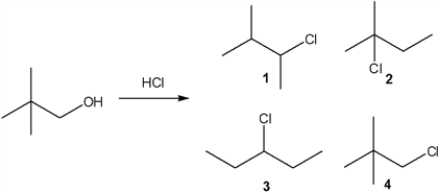
A) 1
B) 2
C) 3
D) 4

A) 1
B) 2
C) 3
D) 4

Unlock Deck
Unlock for access to all 102 flashcards in this deck.
Unlock Deck
k this deck
27
What is the major organic product obtained from the following reaction? 
A) 1
B) 2
C) 3
D) 4

A) 1
B) 2
C) 3
D) 4

Unlock Deck
Unlock for access to all 102 flashcards in this deck.
Unlock Deck
k this deck
28
What is the major organic product obtained from the following reaction? 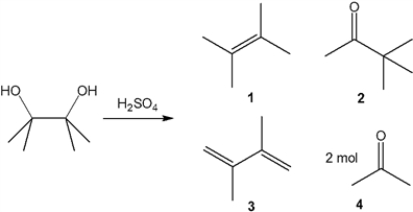
A) 1
B) 2
C) 3
D) 4

A) 1
B) 2
C) 3
D) 4

Unlock Deck
Unlock for access to all 102 flashcards in this deck.
Unlock Deck
k this deck
29
What is the major organic product obtained upon heating a mixture of 3,3-dimethyl-2-butanol, (CH3)3CCH(OH)CH3, with sulfuric acid?
A) 3,3-dimethyl-1-butene
B) 2,3-dimethyl-1-butene
C) 2,3-dimethyl-2-butene
D) tert-butyl alcohol
A) 3,3-dimethyl-1-butene
B) 2,3-dimethyl-1-butene
C) 2,3-dimethyl-2-butene
D) tert-butyl alcohol

Unlock Deck
Unlock for access to all 102 flashcards in this deck.
Unlock Deck
k this deck
30
Which of the following alcohols undergoes the most rapid dehydration upon treatment with H2SO4 to give an alkene? 
A) 1
B) 2
C) 3
D) 4

A) 1
B) 2
C) 3
D) 4

Unlock Deck
Unlock for access to all 102 flashcards in this deck.
Unlock Deck
k this deck
31
What is the major organic product obtained from the following reaction? 
A) 1
B) 2
C) 3
D) 4

A) 1
B) 2
C) 3
D) 4

Unlock Deck
Unlock for access to all 102 flashcards in this deck.
Unlock Deck
k this deck
32
What is the major organic product obtained from the following reaction? 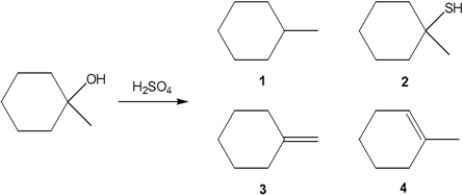
A) 1
B) 2
C) 3
D) 4

A) 1
B) 2
C) 3
D) 4

Unlock Deck
Unlock for access to all 102 flashcards in this deck.
Unlock Deck
k this deck
33
What is the major organic product obtained from the following reaction? 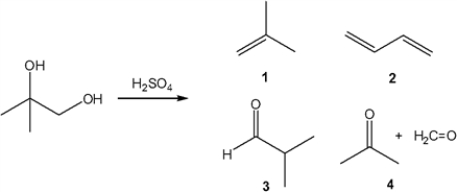
A) 1
B) 2
C) 3
D) 4

A) 1
B) 2
C) 3
D) 4

Unlock Deck
Unlock for access to all 102 flashcards in this deck.
Unlock Deck
k this deck
34
What is the major organic product obtained upon heating a mixture of 2-butanol and 85% H3PO4?
A) 1-butene
B) cis-2-butene
C) trans-2-butene
D) 2-methylpropene (isobutylene)
A) 1-butene
B) cis-2-butene
C) trans-2-butene
D) 2-methylpropene (isobutylene)

Unlock Deck
Unlock for access to all 102 flashcards in this deck.
Unlock Deck
k this deck
35
Which of the following alcohols reacts fastest with HBr to give the corresponding alkyl bromide? 
A) 1
B) 2
C) 3
D) 4

A) 1
B) 2
C) 3
D) 4

Unlock Deck
Unlock for access to all 102 flashcards in this deck.
Unlock Deck
k this deck
36
Which of the following alcohols reacts fastest with HBr to give the corresponding alkyl bromide?
A) methanol
B) ethanol
C) 2-propanol
D) 2-methyl-2-propanol
A) methanol
B) ethanol
C) 2-propanol
D) 2-methyl-2-propanol

Unlock Deck
Unlock for access to all 102 flashcards in this deck.
Unlock Deck
k this deck
37
What is the major organic product obtained from the following reaction? 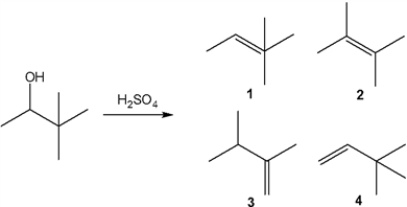
A) 1
B) 2
C) 3
D) 4

A) 1
B) 2
C) 3
D) 4

Unlock Deck
Unlock for access to all 102 flashcards in this deck.
Unlock Deck
k this deck
38
Which of the following alcohols undergoes the most rapid dehydration upon treatment with H2SO4 to give an alkene?
A) methanol
B) ethanol
C) 2-propanol
D) 2-methyl-2-propanol
A) methanol
B) ethanol
C) 2-propanol
D) 2-methyl-2-propanol

Unlock Deck
Unlock for access to all 102 flashcards in this deck.
Unlock Deck
k this deck
39
What is the major organic product obtained from the following reaction? 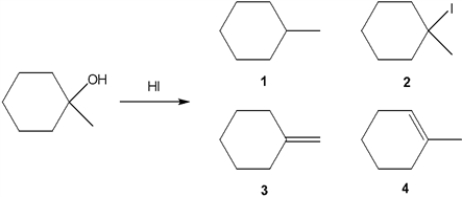
A) 1
B) 2
C) 3
D) 4

A) 1
B) 2
C) 3
D) 4

Unlock Deck
Unlock for access to all 102 flashcards in this deck.
Unlock Deck
k this deck
40
What is the major organic product obtained from the following reaction? 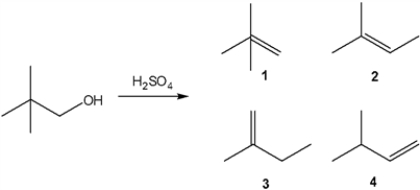
A) 1
B) 2
C) 3
D) 4

A) 1
B) 2
C) 3
D) 4

Unlock Deck
Unlock for access to all 102 flashcards in this deck.
Unlock Deck
k this deck
41
What type of reactive intermediate is formed in the reaction of tert-butyl alcohol with H2SO4 to give methylpropene?
A) tert-butyl cation
B) tert-butyl anion
C) tert-butyl radical
D) tert-butoxide
A) tert-butyl cation
B) tert-butyl anion
C) tert-butyl radical
D) tert-butoxide

Unlock Deck
Unlock for access to all 102 flashcards in this deck.
Unlock Deck
k this deck
42
Consider following structures. 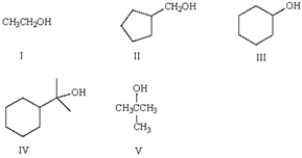 Only structure III represents a secondary alcohol.
Only structure III represents a secondary alcohol.
 Only structure III represents a secondary alcohol.
Only structure III represents a secondary alcohol.
Unlock Deck
Unlock for access to all 102 flashcards in this deck.
Unlock Deck
k this deck
43
What is the major organic product obtained from the following sequence of reactions? 
A) (±)-2-azidopentane
B) (R)-2-azidopentane
C) (S)-2-azidopentane
D) (S)-2-pentyl tosylate

A) (±)-2-azidopentane
B) (R)-2-azidopentane
C) (S)-2-azidopentane
D) (S)-2-pentyl tosylate

Unlock Deck
Unlock for access to all 102 flashcards in this deck.
Unlock Deck
k this deck
44
What is the correct assignment of the names of the following functional groups? 
A) 1 = thiol; 2 = sulfone; 3 = sulfoxide
B) 1 = thiol; 2 = sulfoxide; 3 = sulfone
C) 1 = thiol; 2 = sulfinic acid; 3 = sulfonic acid
D) 1 = sulfonic acid; 2 = sulfone; 3 = sulfinic acid

A) 1 = thiol; 2 = sulfone; 3 = sulfoxide
B) 1 = thiol; 2 = sulfoxide; 3 = sulfone
C) 1 = thiol; 2 = sulfinic acid; 3 = sulfonic acid
D) 1 = sulfonic acid; 2 = sulfone; 3 = sulfinic acid

Unlock Deck
Unlock for access to all 102 flashcards in this deck.
Unlock Deck
k this deck
45
The following substance would be correctly name as 2-pentanthiol.
|
|

Unlock Deck
Unlock for access to all 102 flashcards in this deck.
Unlock Deck
k this deck
46
(CH3)3CO- Na+ would be formed by the reaction of sodium metal and 1-butanol.

Unlock Deck
Unlock for access to all 102 flashcards in this deck.
Unlock Deck
k this deck
47
What is the best choice of reagent to achieve the following transformation? 
A) HCl
B) Cl2, light
C) SOCl2, pyridine
D) HOCl, H2O

A) HCl
B) Cl2, light
C) SOCl2, pyridine
D) HOCl, H2O

Unlock Deck
Unlock for access to all 102 flashcards in this deck.
Unlock Deck
k this deck
48
What is the best choice of reagent to perform the following transformation? 
A) HCl
B) NaOH
C) H2SO4
D) KMnO4

A) HCl
B) NaOH
C) H2SO4
D) KMnO4

Unlock Deck
Unlock for access to all 102 flashcards in this deck.
Unlock Deck
k this deck
49
What type of reactive intermediate is formed in the reaction of tert-butyl alcohol with HCl to give tert-butyl chloride?
A) tert-butyl radical
B) tert-butyl anion
C) tert-butyl cation
D) tert-butoxide
A) tert-butyl radical
B) tert-butyl anion
C) tert-butyl cation
D) tert-butoxide

Unlock Deck
Unlock for access to all 102 flashcards in this deck.
Unlock Deck
k this deck
50
What is the best choice of reagent to perform the following transformation? 
A) HCl
B) NaOH
C) HIO4
D) PCC

A) HCl
B) NaOH
C) HIO4
D) PCC

Unlock Deck
Unlock for access to all 102 flashcards in this deck.
Unlock Deck
k this deck
51
What is the major organic product obtained from the following reaction? 
A) 1
B) 2
C) 3
D) 4

A) 1
B) 2
C) 3
D) 4

Unlock Deck
Unlock for access to all 102 flashcards in this deck.
Unlock Deck
k this deck
52
What is the major organic product obtained from the following reaction? 
A) trans-2-butene, (E) CH3CH=CHCH3
B) butanedione, CH3COCOCH3
C) acetaldehyde, CH3CHO
D) acetic acid, CH3COOH

A) trans-2-butene, (E) CH3CH=CHCH3
B) butanedione, CH3COCOCH3
C) acetaldehyde, CH3CHO
D) acetic acid, CH3COOH

Unlock Deck
Unlock for access to all 102 flashcards in this deck.
Unlock Deck
k this deck
53
What is the major organic product obtained from the following reaction? 
A) 1,6-hexanediol, HO(CH2)6OH
B) hexanedial, OHC(CH2)4CHO
C) hexanedioic acid, HO2C(CH2)4COOH
D) cyclohexene

A) 1,6-hexanediol, HO(CH2)6OH
B) hexanedial, OHC(CH2)4CHO
C) hexanedioic acid, HO2C(CH2)4COOH
D) cyclohexene

Unlock Deck
Unlock for access to all 102 flashcards in this deck.
Unlock Deck
k this deck
54
What is the major organic product obtained from the following reaction? 
A) 1-butene, CH3CH2CH=CH2
B) butanal, CH3CH2CH2CHO
C) butanone, CH3CH2COCH3
D) butanoic acid, CH3CH2CH2COOH

A) 1-butene, CH3CH2CH=CH2
B) butanal, CH3CH2CH2CHO
C) butanone, CH3CH2COCH3
D) butanoic acid, CH3CH2CH2COOH

Unlock Deck
Unlock for access to all 102 flashcards in this deck.
Unlock Deck
k this deck
55
What is the best choice of reagent to perform the following transformation? 
A) PCC
B) HIO4
C) CrO3
D) NaOH

A) PCC
B) HIO4
C) CrO3
D) NaOH

Unlock Deck
Unlock for access to all 102 flashcards in this deck.
Unlock Deck
k this deck
56
What is the major organic product obtained from the following reaction? 
A) 1-butene, CH3CH2CH=CH2
B) butanal, CH3CH2CH2CHO
C) butanone, CH3CH2COCH3
D) butanoic acid, CH3CH2CH2COOH

A) 1-butene, CH3CH2CH=CH2
B) butanal, CH3CH2CH2CHO
C) butanone, CH3CH2COCH3
D) butanoic acid, CH3CH2CH2COOH

Unlock Deck
Unlock for access to all 102 flashcards in this deck.
Unlock Deck
k this deck
57
What is the major organic product obtained from the following sequence of reactions? 
A) 3-methyl-1-butene
B) 2-iodo-2-methylbutane
C) 1-iodo-3-methylbutane
D) 1-chloro-3-methylbutane

A) 3-methyl-1-butene
B) 2-iodo-2-methylbutane
C) 1-iodo-3-methylbutane
D) 1-chloro-3-methylbutane

Unlock Deck
Unlock for access to all 102 flashcards in this deck.
Unlock Deck
k this deck
58
What is the best choice of reagent to achieve the following transformation? 
A) CrO3
B) NaOH
C) PCC
D) HIO4

A) CrO3
B) NaOH
C) PCC
D) HIO4

Unlock Deck
Unlock for access to all 102 flashcards in this deck.
Unlock Deck
k this deck
59
What is the major organic product obtained from the following reaction? 
A) 1
B) 2
C) 3
D) 4

A) 1
B) 2
C) 3
D) 4

Unlock Deck
Unlock for access to all 102 flashcards in this deck.
Unlock Deck
k this deck
60
The following substance would be named as 3-pentyn-1-ol.

Unlock Deck
Unlock for access to all 102 flashcards in this deck.
Unlock Deck
k this deck
61
Consider the following species.  This substance is a _______conjugate base than the substance shown below.
This substance is a _______conjugate base than the substance shown below. 
 This substance is a _______conjugate base than the substance shown below.
This substance is a _______conjugate base than the substance shown below. 

Unlock Deck
Unlock for access to all 102 flashcards in this deck.
Unlock Deck
k this deck
62
To answer the following question, consider the reaction below: 
Provide the complete IUPAC name for the starting material in this reaction.

Provide the complete IUPAC name for the starting material in this reaction.

Unlock Deck
Unlock for access to all 102 flashcards in this deck.
Unlock Deck
k this deck
63
What is the IUPAC name of the following compound? 


Unlock Deck
Unlock for access to all 102 flashcards in this deck.
Unlock Deck
k this deck
64
Of the following compounds, 3 would have the highest boiling point. 1. 2. 3.

Unlock Deck
Unlock for access to all 102 flashcards in this deck.
Unlock Deck
k this deck
65
(CH3)3COH would react faster than (CH3)2CHCH2OH under SN1 conditions.

Unlock Deck
Unlock for access to all 102 flashcards in this deck.
Unlock Deck
k this deck
66
What is the major organic product obtained from the following reaction? 


Unlock Deck
Unlock for access to all 102 flashcards in this deck.
Unlock Deck
k this deck
67
The rate-determining step in the following reaction is protonation of the alcohol. ?

Unlock Deck
Unlock for access to all 102 flashcards in this deck.
Unlock Deck
k this deck
68
Reaction with Na, NaH, or NaOH can be used to irreversibly accomplish the following reaction.

Unlock Deck
Unlock for access to all 102 flashcards in this deck.
Unlock Deck
k this deck
69
Including stereoisomers, the number alkene isomers produced by the acid-catalyzed dehydration of 3-methyl-3-hexanol is _____.

Unlock Deck
Unlock for access to all 102 flashcards in this deck.
Unlock Deck
k this deck
70
What is the IUPAC name of the following compound? 


Unlock Deck
Unlock for access to all 102 flashcards in this deck.
Unlock Deck
k this deck
71
The starting material would be classified as a __________ alcohol.

Unlock Deck
Unlock for access to all 102 flashcards in this deck.
Unlock Deck
k this deck
72
The mechanism of this reaction would be classified as ______.

Unlock Deck
Unlock for access to all 102 flashcards in this deck.
Unlock Deck
k this deck
73
When a secondary (2°) alcohol is treated with Jones reagent the product of the reaction is a ketone.

Unlock Deck
Unlock for access to all 102 flashcards in this deck.
Unlock Deck
k this deck
74
What is the IUPAC name of the following compound (shown as a Fischer projection)? 


Unlock Deck
Unlock for access to all 102 flashcards in this deck.
Unlock Deck
k this deck
75
The rate-determining step in the following reaction is displacement of water from the protonated alcohol by the bromide ion.

Unlock Deck
Unlock for access to all 102 flashcards in this deck.
Unlock Deck
k this deck
76
The pKa of CH3CH2CH2OH is _______than that of CH3CH2CH2SH.

Unlock Deck
Unlock for access to all 102 flashcards in this deck.
Unlock Deck
k this deck
77
If the Ka of isopropyl alcohol is 1.0 × 10-17, the pKa of isopropyl alcohol______.

Unlock Deck
Unlock for access to all 102 flashcards in this deck.
Unlock Deck
k this deck
78
What is the IUPAC name of the following compound (shown as a Fischer projection)? 


Unlock Deck
Unlock for access to all 102 flashcards in this deck.
Unlock Deck
k this deck
79
Consider the following structures. 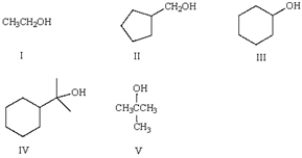 Structure(s)____could be used to produce an aldehyde by reaction with PCC. Enter the number of the appropriate structure. If more than one structure is correct, enter the appropriate numbers separated by commas.
Structure(s)____could be used to produce an aldehyde by reaction with PCC. Enter the number of the appropriate structure. If more than one structure is correct, enter the appropriate numbers separated by commas.
 Structure(s)____could be used to produce an aldehyde by reaction with PCC. Enter the number of the appropriate structure. If more than one structure is correct, enter the appropriate numbers separated by commas.
Structure(s)____could be used to produce an aldehyde by reaction with PCC. Enter the number of the appropriate structure. If more than one structure is correct, enter the appropriate numbers separated by commas.
Unlock Deck
Unlock for access to all 102 flashcards in this deck.
Unlock Deck
k this deck
80
What is the major organic product obtained from the following reaction? 


Unlock Deck
Unlock for access to all 102 flashcards in this deck.
Unlock Deck
k this deck



